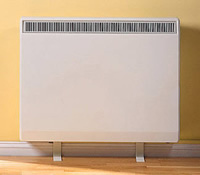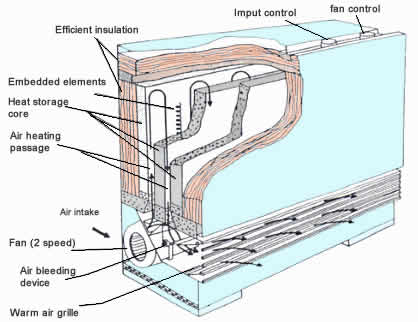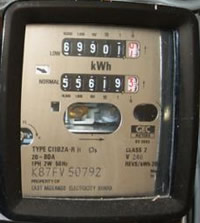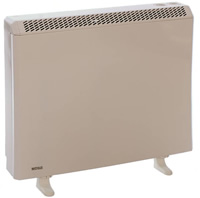
 A night storage heater is an electrical home appliance which stores thermal energy in heat banks, normally clay bricks, during the evening, or at night when electricity is available at lower cost, and releases the heat during the day as required.
A night storage heater is an electrical home appliance which stores thermal energy in heat banks, normally clay bricks, during the evening, or at night when electricity is available at lower cost, and releases the heat during the day as required.
Storage heaters used to be seen as an expensive alternative to provide heat compared to other fuels. Not today – with energy costs soaring, storage heaters now provide a competitive source of controllable heat energy when compared to gas and oil alternatives.
They can be installed anywhere using a simple wall bracket and have no maintenance costs. Rooms can be equipped with modern storage heaters without major installation costs. There is no flue modernisation, expensive pipe work or plumbing necessary and no risks such as Carbon Monoxide poisoning.
The lifetime cost of an electric heat system will be lower than heating using other fuels. Electric heating is energy efficient and more eco friendly than central heating. Storage heaters are ideal for homes that are occupied during the day due to slow heat release throughout the day.
 The early electric storage heaters were bulky and space consuming; and they emitted heat at a set rate, so the user had no control over the output. The heat stored during the night could be adjusted – but this involved making an estimate of the next day’s heating requirements, and a sudden change of weather could leave the user with too much or too little heat.
The early electric storage heaters were bulky and space consuming; and they emitted heat at a set rate, so the user had no control over the output. The heat stored during the night could be adjusted – but this involved making an estimate of the next day’s heating requirements, and a sudden change of weather could leave the user with too much or too little heat.
The main disadvantage is lack of heat control. If excess heat has been stored, heat will be discharged into the room even if it is not needed. If there is unexpected cold weather and insufficient heat has been stored, full price electricity or a secondary heat source i.e. gas or oil will be needed to generate extra heat. Most heaters are heavy due to the clay bricks inside used to store heat.
Improvements in technology and design have enhanced their appeal considerably. Present day electric storage heaters are slimmer – typically 167mm (6.2in) deep – and may either be wall-mounted or freestanding. They retain their heat more efficiently and enable greater control of heat output. Thermostatically controlled adjustable dampers and fans allow the units to be run at low levels in unoccupied rooms and then at a higher level when needed, perhaps late in the day. Some units retain a residue of stored heat, which reduces overnight charging and cuts costs further. Others monitor room temperatures at night, assess the next day’s heating needs (a cold night is normally followed by a cold day) and adjust the heat charge accordingly.
 Economy 7, is a kind of electricity tariff, which means that you pay a different price for your electricity at different times of day.
Economy 7, is a kind of electricity tariff, which means that you pay a different price for your electricity at different times of day.
Because people use less electricity in the small hours of the night the electricity providers are willing to sell electricity cheaper for 7 hours each night a bit like peak and off-peak phone calls. Roughly, the charge for using electrical appliances during these hours is around a third of the regular cost
Economy 7 tariffs use a different kind of electricity meter, which, unlike a standard meter, can track the electricity you use during the day and at night separately.
The Economy 10 system is similar to the much wider used Economy 7 system and gives an extra charge to your system. The hours for the economy 10 tariff are split on usage into three tariff periods (rather than 2 with economy 7) as follows:
Certain night storage heaters would charge up during the night and release some of their heat during the day but not have enough heat left when the family returns home in the evening and turns everything up to full. This is where the Economy 10 system sould come in usefull and recharge in the afternoon and also in the evening. Also tumble dryers, washers and dish washers could be put on timers to come on for the afternoon session meaning that everything would be clean for when you get home and leave the nights free of noisy washers etc.
 Economy 10 is often referred to as a heatwise tariff is only available if you have an economy 10 meter fitted – which is not common but they are available to be installed but you may be charged for the installation. There only appear to be a couple of energy companies that still offer this tariff and those being Eon energy and EDF energy. You’ll also not likely to see these tariffs on price comparison websites or even on the companies we’ve just mentioned. So if you are already on this tariff or want to find more about it then go to those websites for further information or give them a call.
Economy 10 is often referred to as a heatwise tariff is only available if you have an economy 10 meter fitted – which is not common but they are available to be installed but you may be charged for the installation. There only appear to be a couple of energy companies that still offer this tariff and those being Eon energy and EDF energy. You’ll also not likely to see these tariffs on price comparison websites or even on the companies we’ve just mentioned. So if you are already on this tariff or want to find more about it then go to those websites for further information or give them a call.
With the introduction of new smart meter tariffs over the coming years it’s also unlikely that new economy 10 tariffs will be launched and may be phased out completely depending on what happens to the market place once more data is collected from your usage patterns and new smart tariffs are introduced. Certainly npower stopped their economy 10 tariff before 2009 because of lack of demand. So if you are already on economy 10 you should always look to see if there are cheaper tariffs out there either with economy 7 or even discounted standard tariffs.
We employ reliable professionals who are trained to deal with all aspects of electrical faults. AA Electrical Services is a reputable installation, repair and maintenance service company covering the South East area. Our team of electricians provides you with maintenance of your electrical installation and appliances as well as a fast and reliable breakdown service. Recognising current British standards, our electrical engineers are NICEIC registered, Part P accredited and qualified to 17th edition standard, as certified by the Institute of Electrical Engineers (IEE). This enables us to offer the highest levels of professional service to you.